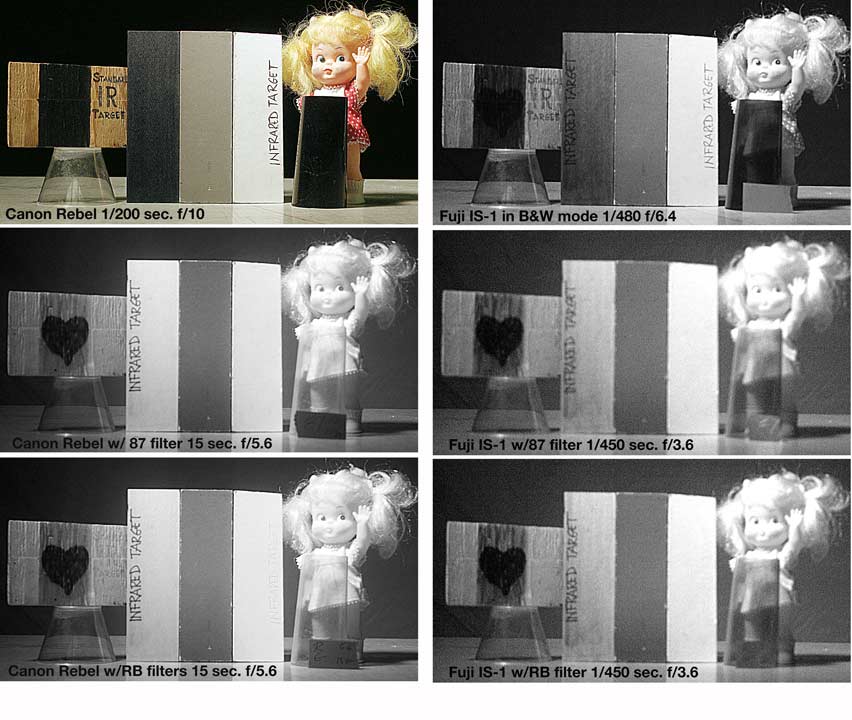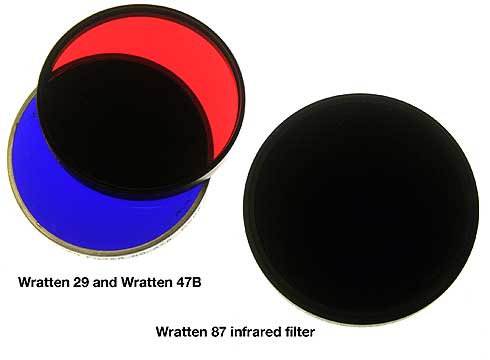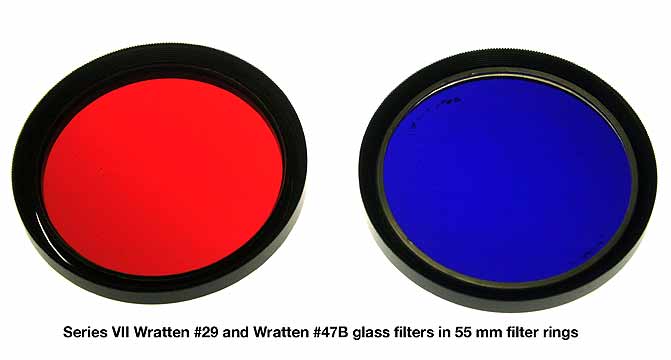Canon Digital Rebel vs. Fuji IS-1 infrared
capable camera
Andrew Davidhazy
Imaging and Photographic Technology
School of Photographic Arts and Sciences / RIT
Andrew Davidhazy
Imaging and Photographic Technology
School of Photographic Arts and Sciences / RIT
This is the result of a test conducted to determine what roughly is the difference between photographing a test target scene with a Canon Digital Rebel in color mode (only mode available!) vs. the Fuji IS-1 infrared capable camera (in B&W mode) with a true Wratten #87 infrared only transmitting filter and a stack of 2 generally readily available dyed glass color filters. The #29 plus the #47B. These may make for a useful improvised IR transmitting filter. The results of the test are shown below:

I failed to keep close tabs on focusing and the Fuji images turned out somewhat out of focus but this will be corrected in the next set of comparisons. In any case in both cases the speed of the sensor was set to 800. The Canon and the Fuji operating without a filter are pretty close in terms of speed. The Canon properly exposed at 1/200 @ f/10 while the Fuji exposed 1/480 @ f/6.4 (which is _roughly_ the same as 1/200 @ f/10).
But once an IR only passing filter was added it is obvious that the Fuji has a great sensitivity advantage when used with the visible blocking filter. The filters used were the Wratten 87 (visually opaque) and a combination of deep red #29 and deep blue #47B glass filters.
 With both a true Wratten 87 filter and the RB filter stack the Canon
required 15 seconds at f/5.6 while the Fuji did well at 1/450 second at
f/3.6. This is a difference of about 12 stops. That means the Fuji is
about 4,000 times more "sensitive" when photographing through an 87
Wratten filter than the Canon (which, of course, was never designed to
be used to capture infrared).
With both a true Wratten 87 filter and the RB filter stack the Canon
required 15 seconds at f/5.6 while the Fuji did well at 1/450 second at
f/3.6. This is a difference of about 12 stops. That means the Fuji is
about 4,000 times more "sensitive" when photographing through an 87
Wratten filter than the Canon (which, of course, was never designed to
be used to capture infrared).Interestingly the difference between the 87 and the stack of Red+Blue filters (a #29 and a #47B) is quite minimal both in terms of exposure requirements and ultimate performance.
Both easily show that the wooden board has a heart painted behind or on top of an infrared transparent (or translucent anyway) visually dark patch. This prevents our eyes from detecting that heart. Black on black = all black to our eyes. But since the infrared can pass through the translucent black area and is blocked by the infrared absorbing paint that was used to paint the heart this makes the heart shape visible. The black heart could also have been painted on black paint that was IR reflective but I don't think so.
Now the writing on the right side of the gray patches ... it was drawn with infrared transparent ink. It is easily visible in the color record and the B&W record made with the Fuji - although the writing is not quite as opaque as in the Canon record due to the fact that the camera is picking up some of the IR that passed through and was reflected back to the camera.
Now the writing on the left side ... it was written with IR opaque ink on a black background that was painted with infrared transparent ink. So by contrast the opaque writing becomes easily visible against a light gray background.
The truly observant will note that the writing gives away the fact the target was not merely flipped as the top of the letters is close to the edge in one version and away from the edge in the other. Also, of course, the white-gray-black arrangement has turned to white-black-white because the left black section is infrared reflective or allows IR to pass so it is then reflected by the material below.
The black tube in front of Trixie ... it is made from reversal color film processed to maximum density. Unexposed but processed Ektachrome. Note that it becomes quite transparent in the infrared records. This indicates that this material also could be used as an IR transmitting, visible blocking, filter. In fact, the Canon seems to be "better" at depicting the black tube as a transparent object than the Fuji. Have to think about this some more. Suggestions?
The scene was lit with a photoflood so plenty of IR was available. Note that the Fuji only required 1/450 second @ f/3.6 with the 87 or the RB combo while without a filter it needed 1/480 @ f/6.4. That is a loss of speed of only about 2 stops. The Canon on the other hand went from 1/200 at f/10 to 15 seconds at f/5.6 or about 14 stops.
OK ... it is proven that the Fuji is superior in terms of IR sensitivity but not really in terms of tonal reproduction of a typical IR scene.
 This test also seems to have proven, however, that one can
successfully improvise an infrared transmitting, visible blocking,
filter (such as the Wratten 87) by stacking a deep blue filter over a
deep red filter. In the figure at left you can see a couple of old Series VII Red and Blue filters
mounted into 55mm filter rings salvaged from discarded filters.
In emergencies when a Wratten 87 may not be available
the stack of Red and Blue filters, seems to be a more than viable alternative!.
This test also seems to have proven, however, that one can
successfully improvise an infrared transmitting, visible blocking,
filter (such as the Wratten 87) by stacking a deep blue filter over a
deep red filter. In the figure at left you can see a couple of old Series VII Red and Blue filters
mounted into 55mm filter rings salvaged from discarded filters.
In emergencies when a Wratten 87 may not be available
the stack of Red and Blue filters, seems to be a more than viable alternative!.If you want to talk to me about this contact me at: andpph@rit.edu
Well, after putting together the above piece I did some poking on the Internet and found that others have had a similar idea in the past. Oh, well ... hopefully that does not detract from the value of this article especially if you have not read about this solution elsewhere. It just points out that what we (or I) sometimes think as being novel has probably already been thought of by someone else. Cheers!